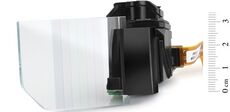Waveguide
A waveguide is a piece of transparent material where an image can be shone in one part and exit another part that is separate. It is useful in making display glasses that use optical see through displays.
A waveguide often serves as a combiner.
Waveguides are often based on diffraction gratings. A diffractive waveguide is a piece of glass or plastic with diffraction gratings on it.
A pupil-expanding waveguide was used in the Magic Leap 1.
Manufacturing[edit]
Waveguides can be built in layers.
Waveguides can be made using lithography.[1]
Companies[edit]
Materials[edit]
Classifications[edit]
A diffractive waveguide has an incoupling and an outcoupling.[1] It uses total internal reflection to get the light from the incoupling to the outcoupling.[1] The incoupling takes in a display source like an LCOS display. The outcoupling is seen by a person's eye.[1]
- Reflective waveguide, advertised by Lumus
- Pupil expansion waveguide - A waveguide that enlarges the image.[3]
References[edit]
- ↑ Jump up to: 1.0 1.1 1.2 1.3 "A Better Way for Manufacturing Diffractive Optics on AR Waveguides". 2024-03-06. https://www.youtube.com/watch?v=7XOj-6YUCCI.
- ↑ Guttag, Karl (2018-09-27). "Magic Leap Review Part 1 – The Terrible View Through Diffraction Gratings". https://kguttag.com/2018/09/26/magic-leap-review-part-1-the-terrible-view-through-diffraction-gratings/.
- ↑ Blanche, Pierre-Alexandre (2019-03-18). "Holographic Combiners Improve Head-Up Displays". https://www.photonics.com/Articles/Holographic_Combiners_Improve_Head-Up_Displays/a64487.
